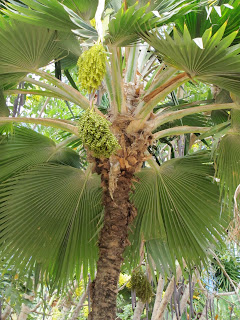When I first started working on projects in the tropics, I was intimidated by all that I didn't know about palms. For a while there, they all looked the same. But eventually with enough exposure you begin to notice the finer details separating one species from another.

The very first step in that direction is by noticed whether or not the leaves are fans or fronds. The way that here on the east coast, when encountering a tree, the first thing we note is leaf orientation (opposite or altnerate?) with palms, noting if it's a fan leaf like the tree in this post, or a compound frond like this morning's date palm, narrows down the possibilities.
The genus in this post is Pritchardia or Pritchard palm, named so after William Thomas Pritchard, a British consul at Fiji during the turn of the last century. If you pressed a gun to my head (please don't), I would speculate that this is Pritchardia affinis or loulu palm, which can become quite tall (many species stay shorter) and is more common than the other 28 species.
P. affinis is endemic to Hawaii and is registered as an endangered species. There are another 18 species of Pritchardia that are also endemic and all are in decline. The genus is unusual in that the flowers and fruits occur on the same stalks. Note the bright yellow flower buds above and the unripe fruit below.



No comments:
Post a Comment